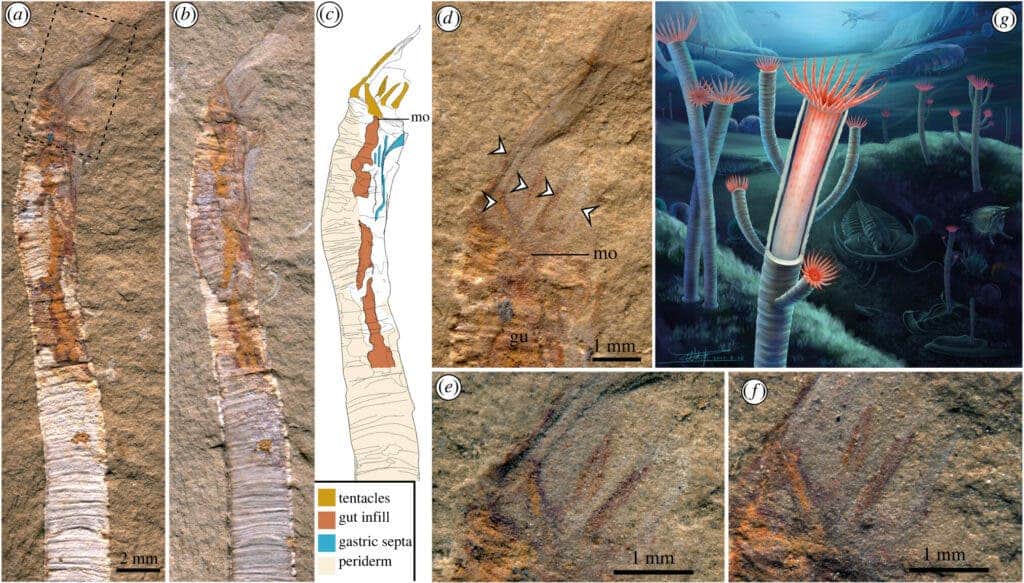A lucky find in the Yunnan Province of China is giving us a chance to see what the first skeletons on Earth looked like.
Skeletons today are quite common; although they’re not on display, each one of us has our own. Our pets, for the most part, have them as well, as do the birds perching outside our windows or the chicken we’ll have for dinner. We also take them as a given when talking about paleontology or archaeology, and you simply can’t have Halloween without a nice faux skeleton on display.
That being said, there was a time in Earth’s history when skeletons were just being invented. A fresh new study is giving us a glimpse into how these — and the animals that created them — looked. The paper describes a group of four 514-million-year-old fossils newly discovered in the Yunnan Province of China. The discovery helps put to rest a centuries-old question regarding the evolution of life on earth.
An old new idea

“This really is a one-in-million discovery. These mysterious tubes are often found in groups of hundreds of individuals, but until now they have been regarded as ‘problematic’ fossils, because we had no way of classifying them,” explains Dr Luke Parry from the Department of Earth Sciences at the University of Oxford, corresponding author of the paper. “Thanks to these extraordinary new specimens, a key piece of the evolutionary puzzle has been put firmly in place.”
Skeletons first appear in the fossil record quite suddenly around 550-520 million years ago, from a period of history known as the Cambrian. This period is characterized by the rapid evolution of many exotic organisms, earning it the nickname of the “Cambrian Explosion”. It was during this time that nature experimented with an incredible array of body shapes and sizes, and it is from this time period that the general body shape and structures of modern animals draw their roots.
That being said, we had virtually no idea what the animals that produced those skeletons looked like. The skeletons themselves resemble simple, hollow tubes that range from a few millimeters to several centimeters in length. However, a lack of any preserved soft tissues meant that researchers couldn’t determine which major family these animals belonged to, and which modern animals they are related to. The newly-discovered fossils help change that.
Four individual Gangtoucunia aspera were discovered at the site in the Gaoloufang section in Kunming, eastern Yunnan Province, China. Anaerobic (oxygen-poor) conditions here limit bacterial activity that normally degrades soft tissues in fossils. So, amazingly, these fossils had soft tissues such as the gut and mouthparts excellently preserved. Based on these fossils, the team could determine that the animal had a circular mouth, fringed with a ring of smooth unbranched tentacles, each around 5 mm in length. They had a blind-ended gut, meaning their digestive tracts were open only on one end, which was partitioned into internal cavities along the length of the tube.
Such a combination of features is only seen today in jellyfish, anemones, and other cnidarians. The tentacles of Gangtoucunia most likely served to sting and capture prey including small arthropods, the team explains, much like those of cnidarians today.
Cnidarians are made entirely of soft tissues, which means that they are exceedingly rare in the fossil record. Gangtoucunia would have most likely looked similar to modern scyphozoan jellyfish polyps, which take on a tubular shape attached to the seafloor at the base. The animal’s mouth was likely capable of extending outside of the tube or retracting in order to avoid predators.
Unlike modern jellyfish polyps, however, Gangtoucunia‘s outer tube was made of calcium phosphate instead of soft tissues.
The discovery helps to, on the one hand, show that these organisms were the unlikely pioneers of skeletons on Earth. On the other hand, they help flesh out the presence of cnidarians in the fossil record, giving us precious information about their evolutionary history and the shapes their ancestors employed.
It also helps prove that Gangtoucunia isn’t related to annelid worms — today’s earthworms and their relatives — as has been previously suggested. The main evidence towards this conclusion is that Gangtoucunia‘s outer body is smooth and its interior partitioned longitudinally, whereas annelids have segmented outer bodies and transverse internal partitioning.
“The first time I discovered the pink soft tissue on top of a Gangtoucunia tube, I was surprised and confused about what they were,” says PhD student Guangxu Zhang, who collected and discovered the specimens, first author of the paper. “In the following month, I found three more specimens with soft tissue preservation, which was very exciting and made me rethink the affinity of Gangtoucunia. The soft tissue of Gangtoucunia, particularly the tentacles, reveals that it is certainly not a priapulid-like worm as previous studies suggested, but more like a coral, and then I realized that it is a cnidarian.”
The paper “Exceptional soft tissue preservation reveals a cnidarian affinity for a Cambrian phosphatic tubicolous enigma” has been published in the journal Proceedings of the Royal Society B: Biological Sciences.









